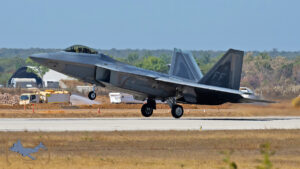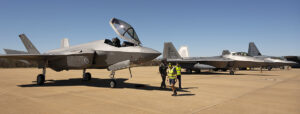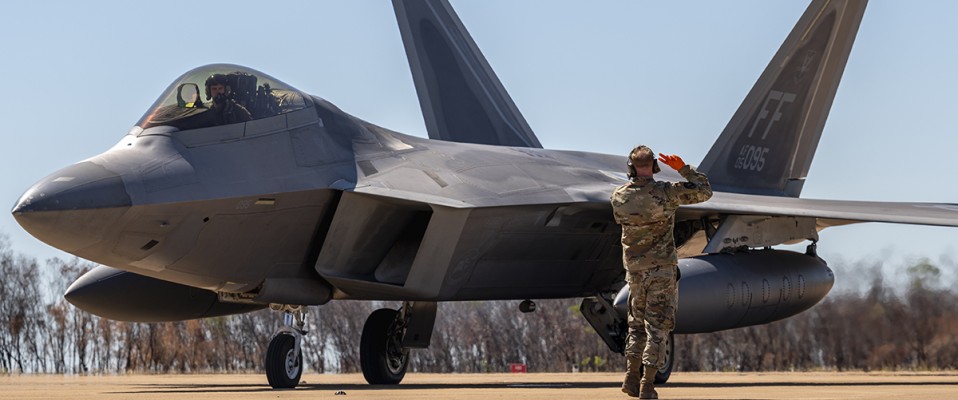U.S. Air Force and Royal Australian Air Force draw closer together during Pitch Black 2024.
Article: Jaryd Stock
Images: Jaryd Stock, Daniel Vorbach and PACAF

Building long-standing working partnerships among nations is one of Exercise Pitch Black 24’s greatest achievements, with those alliances allowing greater integration across the spectrum of operations.
“The U.S. has a long-standing relationship with Australia dating back 80 years to the establishment of the Far East Air Forces, which has only improved since we began participating in Pitch Black in 1983,” said U.S. Air Force General Kevin Schneider, U.S. Pacific Air Forces commander.
“With the scope of Pitch Black, we’re hoping to bring many more countries into these types of events to continue building a worldwide network of specialists to maintain a free and open Indo-Pacific.”
During this year’s Pitch Black, U.S. Air Force members capitalised on the opportunity to work alongside other nations. As an example, F-22 fighter aircraft flew approximately 80 sorties during the exercise, integrating with the 19 other countries throughout.
“We successfully integrated with every participating country during these past few weeks, demonstrating the capabilities of the F-22,” Lieutenant Colonel Ryan “Trap” Nickell 27th Expeditionary Fighter Squadron DET commander, said.
“One of the biggest highlights of the exercise was sharing our unique strengths as a force multiplier for our allies and partners.”
Pitch Black stands to leverage the unique size and favourable weather of Australia’s Northern Territory to invite other countries with an opportunity to work and fly together.
“43 years of Pitch Black for the Royal Australian Air Force, and the U.S. has been part of it the last 41 years,” said U.S. Air Force Colonel Ty Bridge, PACAF Pitch Black lead planner.
“This was the biggest iteration yet, and we plan to continue being a part of it as it grows, to build a network of nations that keep the region safe, secure, and prosperous.”
Asked if more Continental U.S. East Coast based units would participate more with Australian forces in the Indo-Pacific region Col Bridge stated “Absolutely as time progresses we will have more units that don’t have a regular opportunity to train with RAAF come to Australia to build interoperability with our partners here in the Indo-Pacific region.”
The 90th Fighter Squadron apart of PACAF based at Elmendorf Air Force Base, Alaska canceled their deployment to Australia for Pitch Black 24 at the last minute, requiring a substitution with another F-22A Raptor Squadron.
As a result six U.S. Air Force F-22A Raptors assigned to the 27th Expeditionary Fighter Squadron from Joint Base Langley-Eustis, Florida which were deployed to Kadea, Okinawa filled in when the 90th FS was retested at last minute, the aircraft arrived at RAAF Base Tindal where they remained during the three week exercise.
The airmen and women from the 27thEFS conducted a number of mission sets with various countries during the exercise but in particular with RAAF’s No.75 Squadron based at Tindal.

One key feature of the exercise was the 27th EFS conducting hot pit refuels alongside RAAF F-35A Lightning IIs assigned to No.75 Squadron at RAAF Base Curtin, Australia which is a remote austere airfield located near the city of Broome in Western Australia.
A hot pit refuel is an Agile Employment concept designed to sustain airpower by expediting refuelling efforts. This display of interoperable execution in an austere location demonstrated seamless force integration and efficient collaboration between Allies.
“We demonstrated the ability for USAF and RAAF to integrate F-22s with F-35s and deploy outback to a bare base in western Australia,” said “Faux”, 90th Fighter Squadron F-22A pilot.
“This mission was a proof of concept of our ability to fly, fight, and win any time, any place, anywhere with our Allies and partners. RAAF Curtin is a strategic location in ensuring maximum flexibility and the security of a free and open Indo-Pacific.”
Airmen from the 27th Expeditionary Fighter Generation Squadron and RAAF personnel drove the logistics for the operation, including the movement of support personnel, fuel and cargo.
“We’re willing to take risks if it means better agility and combat capability,” said Master Sgt. Luke Ashman, 27th Expeditionary Fighter Generation Squadron aircraft section chief. “The execution of this went very smoothly, the RAAF seems to operate on the same wavelength as us.”
The tactics executed and the lessons learned during the operation provides a paramount advantage to regional security and reinforces Pacific Air Forces’ priority to respond rapidly and effectively to potential future crises and contingencies.
“It is always a challenge going into locations that are not fully developed bases,” said Faux. “Our goal in going was to continue to develop techniques and procedures for non-standard operating locations and prove that we can rapidly and effectively deploy air power to any location, no matter how remote.
By bringing our support personnel and jets from both the USAF and RAAF, we were able to gather invaluable data points for utilising this base for agile employment in the future.”

Royal Australian Air Force F-35A Lighting IIs assigned to the 75th Squadron and U.S. Air Force F-22A Raptors assigned to the 27th Expeditionary Fighter Squadron and await a hot pit refuel at RAAF Base Curtin, Australia. (U.S. Air Force photo by Staff Sgt. Spencer Tobler)
Another key feature of the exercise for the U.S. Air Force was for the embedding of USAF Airmen into Royal Australian Air Force E-7A Wedgetail unit No.2 Squadron through the Military Personnel Exchange Program in preparation of USAF replacing the aging E-3 Sentry Airborne Warning and Control System.
“For us, the purpose is really to get a familiarity of the E-7A Wedgetail from the Australians who have been operating it for a long time,” said U.S. Air Force Maj. Oliver Ngayan, No.2 Squadron E-7A Wedgetail air battle manager.
“We integrate into their unit to learn how they operate the E-7A and take back that knowledge to develop our own procedures.”
For the U.S. Air Force, the program goes beyond familiarity with the Aircraft. Integrated members also work with RAAF members to solve problems and make operations more efficient and effective.
“Most of us have a lot of time on our platforms and we’re learning new ways of doing things,” said U.S Air Force Capt. Trevor Ahnder, No.2 Squadron E-7A Wedgetail pilot.
“RAAF members look at tactics one way, we look at it another, and being able to analyse the differences and find solutions is incredibly valuable. I am incredibly grateful for this opportunity to work together and build better processes.”
While U.S. Air Force Airmen are gaining valuable insights and experience with the Wedgetail, they are also providing information back to their RAAF counterparts ensuring the knowledge exchange flows both ways.
“With the inclusion of the United States Air Force alongside us on aircrew here, we’ve been able to take elements from their long history of the E-3 Sentry and bring that towards the E-7A Wedgetail,” RAAF Squadron Leader Darren Lindsey, 2 Squadron Detachment commander.
“It’s a great privilege to be able to lead the Wedgetail deployment here for Pitch Black 2024 which allows us to integrate with numerous partners, but also showcase to our friends in the United States Air Force.”
Through integrative training efforts with Allies and partners, the U.S. remains interoperable, flexible, and ready to integrate with regional and global counterparts to sustain a free and open Indo-Pacific.
Jaryd Stock is based in Sydney Australia. He has been a die-hard aviation enthusiast from a young age when he was chauffeured around by his father to various airshows and airports around Australia. At his first Airshow he witnessed the awesomeness of a General Dynamics F-111C and immediately fell in love with aviation.
Jaryd picked up a camera at a young age and has never looked back. He now combines photography and writing to highlight “Downunder” aviation; especially U.S. DoD units. Jaryd uses Nikon cameras and lenses.

